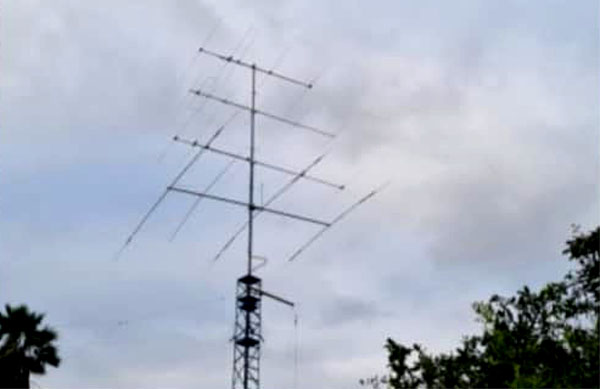Thursday 7th April 2022: There was an extensive opening on the 40 MHz band and it was great to see so many stations active. The map above shows the FT8 activity on the band.
Up to now, the only station active from South Africa seemed to be ZS6WAB so it was a pleasant surprise to see two more ZS stations operating on the 8m band.
Borut, S50B in Slovenia reports working both ZS6OB and ZS4TX bringing his total now to three South African stations worked.
G9PUV on the south-east coast of England managed to exchange signal reports with two stations in South Africa. Even though the signals at 40 MHz were quite strong, no successful contacts were made at 50 MHz when Paul was using his amateur radio callsign G7PUV.
ZS6WAB was heard in Slovenia, Chad and Croatia.
Rcvr Band Mode Distance Time (UTC)
S58P 8m FT8 7928 km 14:59:11
TT8SN 8m FT8 4300 km 14:58:11
9A5CW 8m FT8 7848 km 14:37:28
ZS6OB was heard over a much wider area including Portugal (HC02), Slovenia, Croatia, England, Belgium, France and Hungary.
Rcvr Band Mode Distance Time (UTC)
HC02 8m FT8 7949 km 14:42:59
9A3TN 8m FT8 7983 km 14:42:59
S50B 8m FT8 8098 km 14:42:58
9A5CW 8m FT8 8033 km 14:42:58
S59F 8m FT8 8104 km 14:26:29
G0CHE 8m FT8 8979 km 14:17:14
G4EFE 8m FT8 9060 km 14:17:12
G7PUV/A 8m FT8 8956 km 14:16:45
G9PUV 8m FT8 8964 km 14:16:43
ON5CD 8m FT8 8849 km 14:07:14
G4FTC 8m FT8 9037 km 14:06:44
F5BZB 8m FT8 8196 km 14:05:44
HA2NP 8m FT8 8173 km 13:55:44
ZS4TX was heard in Greece, Slovenia, Portugal, Croatia, England, France and Hungary.
Rcvr Band Mode Distance Time (UTC)
SV1DH 8m FT8 7458 km 14:48:44
S50B 8m FT8 8415 km 14:48:43
HC02 8m FT8 8158 km 14:45:45
S59F 8m FT8 8419 km 14:45:14
9A3TN 8m FT8 8311 km 14:08:56
G9PUV 8m FT8 9243 km 14:00:13
F5BZB 8m FT8 8466 km 13:58:14
HA2NP 8m FT8 8509 km 13:57:44
9A5CW 8m FT8 8349 km 13:53:43
As can be seen from the reports about, the best conditions seemed to have been around 14:00 UTC. I suspect the opening was due to afternoon TEP with some F2 layer propagation.
Radio amateurs in South Africa first got an allocation at 40 MHz back in 2015. After some initial interest, interest seemed to fizzle out due to the small numbers and a lack of activity.
Now with the increased level of activity and interest in the 40 MHz band in Europe, some long range paths are beginning to open up.
As more stations get active on the 40 MHz band, it's likely that more people will put up dedicated antennas tuned for the 8m band resulting in better signal reports. Up to now, most were pressing their 28 MHz or 50 MHz antennas in service with limited results.
Spots from the DX-Cluster...
Spotter Freq. DX Time Info Country
TT8SN 40675 ZS6WAB 14:59 07 Apr 22 JK72MC<>KG46 CQ ... +32 dB South Africa
ON5QRP-@ 40680 ZS6WAB 14:47 07 Apr 22 +06 QSB South Africa
ON5QRP-@ 40680 ZS6OB 14:42 07 Apr 22 +6db South Africa
S50B 40680 ZS6OB 14:32 07 Apr 22 ssb 8m South Africa
F4CXO 40680 ZS6OB 14:32 07 Apr 22 JN26PP<>KG44DE 53 in JN26 South Africa
F4CXO 40675 ZS6WAB/B 14:14 07 Apr 22 JN26PP<>KG46RB 559 South Africa
F4DNP 40675 ZS6WAB/B 14:11 07 Apr 22 Good conditions in JN38. South Africa
EA3ERE 40675 ZS6WAB/B 14:11 07 Apr 22 JN11CX<>KG46 CW 559+ South Africa
EA3ERE 40680 ZS6OB 14:05 07 Apr 22 <ES> FT8 +24 dB cq South Africa
ON5QRP-@ 40680 ZS6OB 14:03 07 Apr 22 +30db South Africa
HA2NP 40680 ZS4TX 14:03 07 Apr 22 JN97SG<TEP>KG30BX 0dB HRD South Africa
HA2NP 40680 ZS6OB 14:02 07 Apr 22 JN97SG<TEP>KG44DE -10 HRD South Africa
ON5QRP-@ 40680 ZS4TX 14:01 07 Apr 22 QSO G9PUV South Africa
G7PUV 40675 ZS6WAB/B 13:54 07 Apr 22 JO00AU<TEP>KG46RB 599! South Africa
TT8SN 40680 S59F 13:48 07 Apr 22 JK72MC<>JN65UU +30 dB Slovenia
TT8SN 40680 ON5QRP 13:47 07 Apr 22 JK72MC<>JN29UQ +12 dB Belgium
ON5QRP-@ 40680 ZS6OB 13:47 07 Apr 22 QSO G9PUV South Africa
EA3ERE 40680 ZS6OB 13:44 07 Apr 22 <ES> FT8 cq South Africa
EA3ERE 40675 ZS6WAB/B 13:33 07 Apr 22 JN11CX<>KG46 CW 549 South Africa
ON5QRP-@ 40680 ZS6OB 13:11 07 Apr 22 -6 ft8 South Africa
F4CXO 40675 ZS6WAB/B 13:09 07 Apr 22 JN26PP<>KG46RB 519 South Africa































